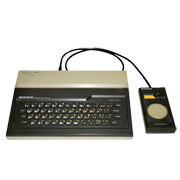Sord (today, the Toshiba Personal Computer System Corporation) announced the M5, a household personal computer, in October 1982.
Fitted with a 3.58 MHz Z80 CPU and priced at under \50,000, this model was directly aimed at getting computers in homes. It had a ROM cassette interface and software was provided on ROM cartridges.
The M5 was provided on an OEM basis to Takara and was sold as a gaming device with an accompanying joypad.
Its original concept, though, was as a proper household computer, not a gaming device. It was equipped with a built-in keyboard and preloaded with the BASIC-I programming language.
Predating Nintendo's family computer in 1983 and the MSX home computer architecture promoted by Microsoft and the ASCII Corporation, the M5 paved the way for household hobby computers.
| CPU | Z80 (3.58 MHz) |
|---|---|
| Sound generator | SN76489A with three square wave generators, one white noise generator, and seven envelope filters |
| ROM | 8 KB (internal monitor), expandable to 24 KB with an external cartridge |
| RAM | 20 KB (of which 16 KB were VRAM), expandable to 24 KB with an external cartridge, expandable to 52 KB with an extension box |
| Keyboard | Full-sized keys (in Japanese syllabary order) with a hiragana key |
| RF outputs | Video, audio, NTSC format, designed for color TVs using either Channel 1 or Channel 2, 75 ohms |
| Display | 16 colors, four modes, 32 sprite images — 32 sprites could be used simultaneously |
| Video output | NTSC format |
| Audio output | Approx. 1 volt peak-to-peak |
| External interfaces | Audio cassette interface, parallel printer interface, cartridge connector |
| External dimensions (w×d×h) | 262×185×35 millimeters (B5 size) |
| Weight | 800 g (main unit only) |
| Standard accessories | BASIC-I ROM cartridge, AC adaptor, signal cable for audio cassettes, TV connector cord (with an antenna switch), standard game cassette tape (with two games) |


